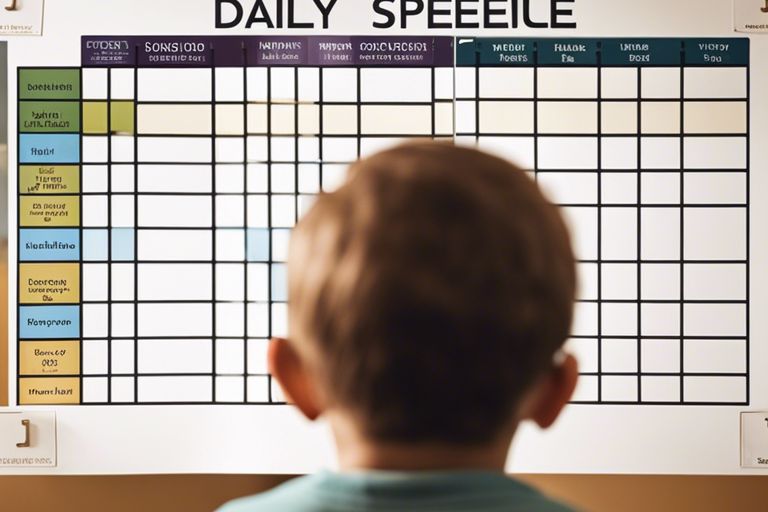When discussing Autism and Routine, it’s essential to acknowledge the profound impact that structure can have on individuals with autism. Maintaining a consistent routine is not merely a matter of preference; it is a crucial element that can significantly influence the well-being and development of individuals on the autism spectrum. In this blog post, we will investigate into the significance of routine for individuals with autism, exploring how structure can provide a sense of security, reduce anxiety, and enhance daily functioning. We will discuss why consistency is key in supporting individuals with autism and how deviations from routine can pose challenges. For more insights on this topic, you can also read our related post on Understanding the Importance of Consistency in Autism.
Key Takeaways:
- Routine is crucial: Individuals with autism thrive on predictability and structure, so establishing and maintaining a routine can greatly benefit their well-being.
- Structure minimises anxiety: Having a predictable schedule and familiar rituals can reduce anxiety and help individuals with autism feel more in control of their environment.
- Flexibility within structure: While routine is essential, allowing for some flexibility can also be beneficial as it teaches individuals how to adapt to changes in a controlled manner.

The Psychological Basis for Structure in Autism
Individuals with autism often benefit greatly from having a structured routine. This need for structure is deeply rooted in the psychological makeup of individuals with autism, providing them with a sense of predictability and stability in their daily lives.
Need for Predictability
One of the key reasons why structure is so important for individuals with autism is the need for predictability. Uncertainty and sudden changes can cause significant distress and anxiety, making it challenging for individuals with autism to navigate their environment. Having a structured routine helps individuals with autism know what to expect, reducing anxiety levels and promoting a sense of security.
Consistency in their daily schedule can provide a sense of stability that is crucial for individuals with autism. Knowing what activities will occur and when they will happen can help reduce feelings of being overwhelmed and help individuals better cope with the demands of daily life.
Cognitive and Sensory Benefits
In addition to providing predictability and stability, structured routines offer cognitive and sensory benefits for individuals with autism. Engaging in familiar activities can help individuals with autism focus their attention, improve their organisational skills, and enhance their ability to process information.
Moreover, the sensory aspects of a structured routine can also be beneficial for individuals with autism. By following a consistent routine, individuals can anticipate sensory input and prepare themselves for any sensory challenges, ultimately reducing sensory overload and enhancing their overall well-being.

Creating Effective Routines for Individuals with Autism
Strategies for Establishing Routines
Establishing routines is crucial for individuals with autism as it provides a sense of predictability and security in their daily lives. One effective strategy is to start with a visual schedule that outlines the activities planned for the day. This visual aid helps individuals understand what to expect and what is required of them, reducing anxiety and confusion.
Consistency is key when establishing routines for individuals with autism. Set clear expectations and stick to the schedule as much as possible. Using visual timers or alarms can help in transitioning between activities smoothly, preparing the individual for what comes next.
Flexibility within Structure
While routine is essential, it’s equally important to incorporate flexibility within the structure to accommodate unexpected changes or new activities. Building in breaks or allowing for some choice within set activities can help individuals with autism feel more in control and empowered.
Flexibility should not compromise the overall structure but rather enhance it by teaching individuals how to adapt to different situations. This balance between routine and flexibility is key in promoting independence and reducing anxiety in individuals with autism.
It is important to strike a balance between maintaining a structured routine and allowing for flexibility to meet the individual’s changing needs. By incorporating elements of choice and adjusting activities when necessary, individuals with autism can develop essential life skills while still feeling supported and secure.
Challenges and Solutions
Handling Disruptions in Routine
Autistic individuals often thrive on predictability and routine, finding comfort and security in the structure of their daily activities. Unexpected disruptions in routine can lead to anxiety, stress, and meltdowns. To handle disruptions effectively, it is essential to communicate changes in advance and provide visual schedules or cues to help prepare the individual for any deviations from their routine.
Another solution to managing disruptions is to maintain flexibility within the routine itself. By building in time buffers or alternative options, individuals with autism can learn to adjust to unexpected changes without becoming overwhelmed. It is important to acknowledge their feelings and provide support during such times to help them regain a sense of control and stability.
Adapting Routines to Different Environments
When transitioning to different environments, such as school, work, or social gatherings, individuals with autism may face challenges in maintaining their routines. To adapt routines successfully, preparation is key. Providing social stories or transition plans can help individuals understand what to expect in a new environment and how they can incorporate their routines into that setting.
Creating a consistent set of core activities within the routine that can be adapted to different environments will also help individuals with autism feel more secure and grounded when faced with changes. By maintaining familiar elements while introducing new ones gradually, individuals can cope better with the demands of varied environments.
It is important to emphasise the benefits of adapting routines to different environments, as this enhances the individual’s ability to navigate diverse settings and builds resilience in the face of uncertainty. By supporting and encouraging individuals with autism to flexibly adapt their routines, we can help them thrive in a variety of situations.

Real-life Applications and Success Stories
Educational Settings
Structured routines in educational settings play a crucial role in supporting children with autism. By providing clear schedules and predictable activities, schools can help individuals with autism navigate their day more effectively. For example, a consistent timetable can reduce anxiety and improve focus, leading to better engagement and learning outcomes.
One success story involves a young student who struggled with transitions between subjects due to sensory sensitivities. Through the implementation of a visual timetable and sensory-friendly classroom adaptations, the student was able to participate more actively in lessons and manage transitions more smoothly, ultimately enhancing their academic performance.
Home and Family Life
In the home environment, establishing routines is equally beneficial for individuals with autism. Consistent daily structures can help reduce meltdowns, promote independence, and improve overall well-being. For instance, a bedtime routine involving calming activities can assist in regulating sleep patterns and promoting a restful night’s sleep.
One family’s experience highlights the impact of incorporating predictable routines into daily life. By establishing set meal times, designated play periods, and bedtime rituals, the family noticed a significant reduction in behavioural challenges and an increase in harmony within the household.
Consistency and predictability are key in creating a supportive environment for individuals with autism in their home and family life. By maintaining structured routines and incorporating visual supports where necessary, families can foster a sense of security and promote positive interactions among members, leading to a more peaceful and balanced home environment.
Conclusion: Autism and Routine – Understanding the Importance of Structure
Understanding the significance of structure and routine for individuals with autism is crucial in creating a supportive environment for their well-being. Consistency in daily activities can provide a sense of predictability and security, reducing anxiety and enhancing overall functioning. By acknowledging the unique needs of individuals with autism and implementing structured routines, we can facilitate their abilities, promote independence, and foster a sense of stability in their lives. It’s essential to embrace and respect the importance of routine in the lives of those with autism, as it plays a vital role in their development and quality of life.
FAQ
Q: What is autism?
A: Autism is a complex developmental disorder that affects social interaction, communication, and behaviour.
Q: What is routine?
A: Routine refers to a sequence of actions regularly followed in a set manner.
Q: Why is routine important for individuals with autism?
A: Routine provides predictability and stability, which can help reduce anxiety and improve coping skills for individuals with autism.
Q: How does routine benefit individuals with autism?
A: Routine helps individuals with autism feel a sense of security, improves their ability to manage transitions, and enhances their overall well-being.
Q: What happens when there is a disruption in routine for individuals with autism?
A: Disruptions in routine can lead to increased anxiety, challenging behaviours, and difficulty in adapting to change for individuals with autism.
Q: How can parents and caregivers support the development of routines for individuals with autism?
A: Parents and caregivers can support the development of routines by creating visual schedules, setting clear expectations, and providing ample time for transitions.
Q: What are some strategies for establishing and maintaining routines for individuals with autism?
A: Some strategies include using visual supports, incorporating sensory activities, breaking tasks into smaller steps, and gradually introducing changes to the routine.







